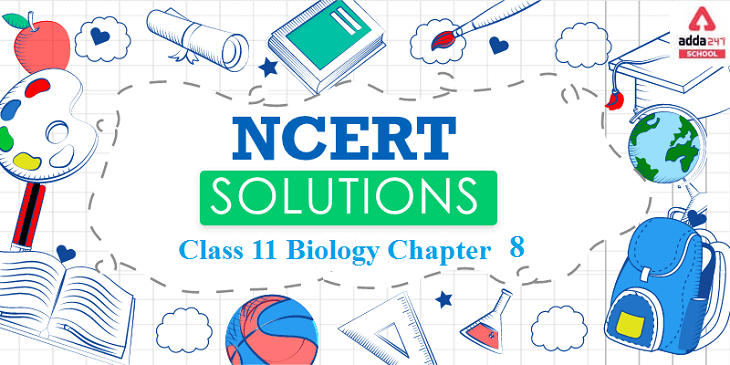NCERT Solutions for Class 11 Biology Chapter 8 in English
Class 11 Biology NCERT Solutions: Adda 247 provides NCERT Solutions for Class 11 Biology which is for the students who want to go ahead in life and achieve great marks in their examinations. The NCERT Solutions are provided by the teachers who are experts of their subjects. The solutions are set according to the rules formulated by the NCERT and in the language that can be understood by every student. By these reading, the solutions students can build up a strong base easily. The NCERT class 11 Biology solutions cover chapters 1 to 22 with the important questions and the answers in a detailed way.
Examinations can be threatening for some people, a proper learning of the concepts is the key to crack the examination. Students rely on the solutions of the NCERT provided by Adda 247. The solutions are formulated by the experts of the subjects who have tremendous knowledge in their subjects.
These NCERT Solutions help the students to get familiarized with the textbooks. The students can access the solutions anywhere while browsing the web easily. The solutions are very precise and accurate.
NCERT Solutions for Class 11 Biology Chapter 8 – Cell: The Unit of Life
The chapter provides information about Cell: The unit of life. The chapter explains that all living and non-living organisms are made of cells. Also, the cells vary in shape, size, structure, and function. Furthermore, based on the presence and absence of membrane that bounds nucleus and other organelles they can be named as eukaryotic and prokaryotic. Moreover, a eukaryotic cell typically contains a cell membrane, cytoplasm, and nucleus. In addition, the plant cells have a cell wall outside the cell membrane. Most noteworthy, the plasma membrane is selectively permeable and facilitates the transport of several molecules. Furthermore, the endomembrane system includes the Golgi complex, ER, lysosomes, and vacuoles. Besides, all the cell organelles perform different but specific functions.
The centrosome and centriole form the basal body of cilia and flagella that aids locomotion. In addition, in animal cells, the centrioles form the spindle apparatus during cell division. The nucleus contains nucleoli and chromatin network. Besides, Endoplasmic reticulum contains tubules or cisternae. Also, they are of two types- rough and smooth. Moreover, ER assists in the transport of substances, synthesis proteins, lipoproteins, and glycogen. Lysosomes are single membrane structures that contain enzymes for the digestions of macromolecules. Furthermore, ribosomes perform the function of protein synthesis. Mitochondria aids in oxidative phosphorylation. Most noteworthy, the nuclear envelope encloses the nucleus. This nuclear envelope is a double membrane structure with nuclear pores.
[sso_enhancement_lead_form_manual title=”Download Full PDF of Class 11 Biology Chapter 8 ” button =”Download Now” pdf =”/jobs/wp-content/uploads/2021/06/15102317/English-chapter-8.pdf”]
Features of the NCERT Solutions for Class 11 Biology Chapter 8- Cell: The unit of Life
NCERT Solutions have been answered based on the important information on the question.
- The columns are used wherever necessary.
- Solutions are solved point wise and accurately answered point to point.
Important Questions NCERT Solutions Class 11 Biology Chapter 8
Question 1. Which of the following is not correct?
(a) Robert Brown discovered the cell.
(b) Schleiden and Schwann formulated the cell theory.
(c) Virchow explained that cells are formed from pre-existing cells.
(d) A unicellular organism carries out its life activities within a single cell.
Answer: Robert Brown did not discover the cell. The cell was discovered by Robert Hook.
Question 2. New cells generate from
(a) bacterial fermentation (b) regeneration of old cells (c) pre-existing cells (d) abiotic materials
Answer: According to the biogenic theory, new cells arise from pre-existing cells. Only complete cells, in favourable conditions, can give rise to new cells.
- Match the following
| Column I | Column II |
| (a) Cristae | (i) Flat membranous sacs in stroma |
| (b) Cisternae | (ii) Infoldings in mitochondria |
| (c) Thylakoids | (iii) Disc-shaped sacs in Golgi apparatus |
Solution:
| Column I | Column II |
| (a) Cristae | (ii) Infoldings in mitochondria |
| (b) Cisternae | (iii) Disc-shaped sacs in Golgi apparatus |
| (c) Thylakoids | (i) Flat membranous sacs in stroma |
Question 4. Which of the following is correct?
(a) Cells of all living organisms have a nucleus.
(b) Both animal and plant cells have a well-defined cell wall.
(c) In prokaryotes, there are no membrane bound organelles.
(d) Cells are formed de novo from abiotic materials
Answer: Membrane-bound organelles are organelles surrounded by a double or a single membrane like Nucleus, mitochondria, chloroplasts, Lysosomes, ER, Golgi bodies etc. are examples of such organelles. These cell organelles are absent in prokaryotes.
Question 5. What is a mesosome in a prokaryotic cell? Mention the functions that it performs.
Answer: Mesosome is a complex membranous structure formed by the infoldings of the plasma membrane in prokaryotic cells. The functions performed by mesosome are as follows:
- Mesosomes play important roles in cell wall formation, DNA replication etc.
- Mesosomes are folded structures, this quality helps to increase the surface area of the plasma membrane to carry out enzymatic activities.
- Mesosome also helps in cellular respiration and secretion.
Question 6. How do neutral solutes move across the plasma membrane? Can the polar molecules also move across it in the same way? If not, then how are these transported across the membrane?
Answer: Plasma membrane is the outermost covering of the cell and regulates the movement of substances into the cell and out from it. It allows the entry of only some substances and prevents the movement of other materials. Hence, the membrane is selectively-permeable.
Movement of neutral solutes across the cell membrane – Neutral molecules move across the plasma membrane by simple passive diffusion. Diffusion is the movement of molecules from a region of higher concentration to a region of lower concentration.
Movement of polar molecules across the cell membrane – The cell membrane is made up of a phospholipid bilayer and proteins. The movement of polar molecules across the non-polar lipid bilayer requires carrier-proteins. Which are integral protein particles having certain affinity for specific solutes. As a result, they facilitate the transport of molecules across the membrane.
Question 7. Name two cell-organelles that are double membrane-bound. What are the characteristics of these two organelles? State their functions and draw labelled diagrams of both.
Answer: Cell organelles that are double membrane-bound are
- Mitochondria
- Chloroplast
(a) Mitochondria: It is a double membrane-bound structure with the outer membrane and the inner membrane dividing its lumen distinctly into two aqueous compartments i.e. outer compartment and inner compartment. The inner compartment is called ‘matrix’. The inner membrane forms a number of infolding called the cristae towards the matrix. Two membranes have their own specific enzymes associated with the mitochondrial function. Mitochondria are the sites of aerobic respiration. They produce cellular energy in the form of ATP and called ‘power house’ of the cell. The matrix also possesses single circular DNA molecule, a few RNA molecules, ribosomes (FOS) and the components required for the synthesis of proteins.
(b) Chloroplast: Chloroplasts are the plastids that contain chlorophyll pigments which are present in plant cells and euglenoids. The space limited by the inner membrane of the chloroplast is called the ‘stroma’. Stroma contains number of organised flattened membranous sacs called the thylakoids. Thylakoids are arranged in stacks called ‘grana’. Different grana are connected by flat membranous tubules called stroma lamellae. Space inside thylakoids is called lumen. The stroma of the chloroplast contains enzymes required for the synthesis of carbohydrates and proteins. It is the site of dark reaction. Chlorophyll pigments are present in the thylakoids which along with carotenoid pigments are responsible for trapping light energy essential for photosynthesis. Grana is the site of light reaction
Question 8. What are the characteristics of prokaryotic cells?
Answer: Prokaryotic cells do not possess a membrane bound nucleus. The characteristics are:
(i) They are small in size 0.1mm to 10mm.
(ii) They do not have membrane bound nucleus.
(iii) They have a circular DNA as the genetic material.
(iv) They have mesosomes for respiration.
(v) They can be autotrophs or saprotrophs.
Question 9. Multicellular organisms have division of labour. Explain.
Answer: Multicellular organisms are made up of millions and trillions of cells. All these cells perform
specific functions. All the cells specialised for performing similar functions are grouped together as
tissues in the body. Hence, a particular function is carried out by a group of cells at a definite place in
the body. Similarly, different functions are carried out by different groups of cells in an organism and
this is known as division of labour in multicellular organisms.
Question 10. The cell is the basic unit of life. Discuss in brief
Answer: All organisms begin their life in a single cell. Certain organisms complete their life cycle as a single cell. They are called unicellular or acellular organisms, e.g., Amoeba, Chlamydomonas bacteria and yeast. In other organisms, the single cell undergoes divisions to form multicellular body. Body of human being, is made up of trillion of cells. All the cells of an organism carry the same genetic material, develop from same pre-existing cells and possess several organelles to perform various life activities. The cells are therefore, basic unit of life and structural unit of an organism.









 NIOS 10th Result 2025 Out @results.nios....
NIOS 10th Result 2025 Out @results.nios....
 Mahatma Gandhi Central University CUET C...
Mahatma Gandhi Central University CUET C...
 CUET BBAU Cutoff 2025, Check Category Wi...
CUET BBAU Cutoff 2025, Check Category Wi...









